Huawei's visible light communication technology uses ubiquitous visible light resources to achieve short-distance communication between access devices and user terminals, saving the existing communication spectrum. At the same time, it can also avoid weaknesses such as leakage of electromagnetic signals in radio communications, and quickly build a secure information space that is resistant to interference and interception.
Not long ago, the world's first commercial-grade ultra-wideband visible light communication dedicated chip developed by my country was officially released at the China International Intelligent Industry Expo. It can support high-speed transmission at the gigabits per second level and provide chip-level products for visible light communication applications in the fields of indoor green ultra-wideband information networks, virtual reality-based home smart services, and high-speed wireless data transmission.
Visible light communication technology can make full use of light to communicate and transmit data at high speed while illuminating. Currently, practical visible light communication is mainly based on LED white light. It is estimated that LED will occupy more than 50% of the lighting market in the future, promoting visible light communication to commercialize and develop rapidly. However, in existing scenarios, due to the problems of high transmission power consumption and low transmission efficiency of visible light transmission, only downlink data can be transmitted to user terminals, but it is difficult for terminals to use visible light to feedback data to devices, making two-way communication difficult to achieve, limiting the application of visible light communication.
In response to this problem, on October 17, 2016, Huawei proposed an invention patent entitled "Visible Light Communication VLC Related Equipment and Methods" (application number: 201480077983.7), and the applicant was Huawei Technologies Co., Ltd.
This patent mainly provides a device and method for using visible light communication (VLC), which is used to realize timely data feedback to the visible light device when the terminal can only receive visible light data. After receiving the data packet transmitted by the device through the visible light link, the user terminal sends data to the device through its own wireless communication function other than visible light communication, thereby realizing two-way data transmission.

Figure 1 Structure diagram of user terminal and visible light communication equipment
The left side of Figure 1 shows the structural module of the user terminal. The VLC receiving module 101 is used to receive the data packet transmitted through the visible light link and pass it to the logical control link (LLC) module 102. The LLC module uses the received data packet to generate a response message with a successful reception mark. Finally, the wireless communication module 103 converts this response message into a radio frequency signal and sends it to the VLC device. The structure of the visible light communication device is shown on the right side of Figure 1. The communication module 201 is used to receive the communication signal carrying the response information and send it to the LLC entity module 202. In the LLC module, the terminal successfully receives the data packet mark according to the response information data, and transmits it to the VLC transmitting module 203, and starts the next round of communication data transmission using visible light. In this data interaction process, the communication signal fed back by the user terminal to the VLC device can be a WiFi signal, a BT signal, an IR signal, a cellular network signal, etc.

Figure 2 Flowchart of the method for realizing visible light bidirectional communication
The flow chart of visible light two-way communication is shown in Figure 2. The access point device provides services, integrates VLC lights and short-range wireless communication functions, and has a VLC transmission module (including MAC layer, physical layer, light-emitting devices, etc.) and a short-range wireless communication module, such as a WiFi module. When the user's data arrives at the access point device, the LLC module converts the data into a numbered LLC data packet, passes it to the VLC transmission module, and sends it to the user device through the VLC light. The VLC receiving module of the user device passes the successfully received LLC data packet to the LLC module of the terminal, and sends an LLC layer ACK message to the access point device through the WiFi module, indicating that the terminal has successfully received it. At this time, the access point device obtains the data, calculates which data is successfully received by the user, and determines whether data retransmission is required.
Based on this technical solution, in the visible light communication scenario, the terminal feeds back uplink data to the visible light communication device through a wireless signal, thereby enabling the terminal to feed back data to the VLC device when it can only receive visible light data, thus achieving two-way data transmission, thereby utilizing visible light spectrum resources, improving the communication rate of the access point, and better meeting the user's data service needs.
The above is Huawei's visible light communication technology, which uses ubiquitous visible light resources to achieve short-distance communication between access devices and user terminals, saving the existing communication spectrum. At the same time, it can also avoid weaknesses such as leakage of radio communication electromagnetic signals, and quickly build a secure information space that is resistant to interference and interception.
Previous article:Is there still a chance for GaAs in the RF PA field?
Next article:Keysight's 5G network and channel emulation solutions help Rakuten deploy new infrastructure
- Popular Resources
- Popular amplifiers
- Wi-Fi 8 specification is on the way: 2.4/5/6GHz triple-band operation
- Three steps to govern hybrid multicloud environments
- Microchip Accelerates Real-Time Edge AI Deployment with NVIDIA Holoscan Platform
- Keysight Technologies FieldFox handheld analyzer with VDI spread spectrum module to achieve millimeter wave analysis function
- Qualcomm launches its first RISC-V architecture programmable connectivity module QCC74xM, supporting Wi-Fi 6 and other protocols
- Microchip Launches Broadest Portfolio of IGBT 7 Power Devices Designed for Sustainable Development, E-Mobility and Data Center Applications
- Infineon Technologies Launches New High-Performance Microcontroller AURIX™ TC4Dx
- Rambus Announces Industry’s First HBM4 Controller IP to Accelerate Next-Generation AI Workloads
- NXP FRDM platform promotes wireless connectivity
- LED chemical incompatibility test to see which chemicals LEDs can be used with
- Application of ARM9 hardware coprocessor on WinCE embedded motherboard
- What are the key points for selecting rotor flowmeter?
- LM317 high power charger circuit
- A brief analysis of Embest's application and development of embedded medical devices
- Single-phase RC protection circuit
- stm32 PVD programmable voltage monitor
- Introduction and measurement of edge trigger and level trigger of 51 single chip microcomputer
- Improved design of Linux system software shell protection technology
- What to do if the ABB robot protection device stops
- Keysight Technologies Helps Samsung Electronics Successfully Validate FiRa® 2.0 Safe Distance Measurement Test Case
- Innovation is not limited to Meizhi, Welling will appear at the 2024 China Home Appliance Technology Conference
- Innovation is not limited to Meizhi, Welling will appear at the 2024 China Home Appliance Technology Conference
- Huawei's Strategic Department Director Gai Gang: The cumulative installed base of open source Euler operating system exceeds 10 million sets
- Download from the Internet--ARM Getting Started Notes
- Learn ARM development(22)
- Learn ARM development(21)
- Learn ARM development(20)
- Learn ARM development(19)
- Learn ARM development(14)
- The principle of phase-locked loop frequency control
- [AutoChips AC7801x motor demo board evaluation] Development environment construction
- Arteli AT32F413 to AT32F415 Migration Guide_V1.0.0
- How to select components in the box?
- Showing off the i.MX6 development board
- [Xianji HPM6750 Review 10] Drawing a multi-function expansion board and verification
- About the distance of infrared obstacle avoidance circuit
- Repost - Tesla battery violent disassembly video
- Relationship between transformer and inductor
- How to port uCOS-II to LPC17XX

 TC52N2846ECTRT
TC52N2846ECTRT
















 京公网安备 11010802033920号
京公网安备 11010802033920号